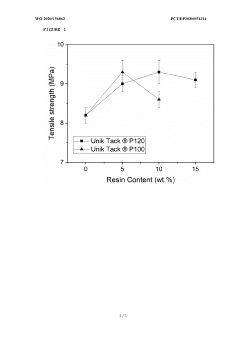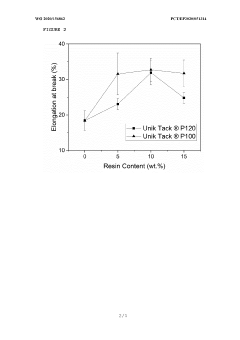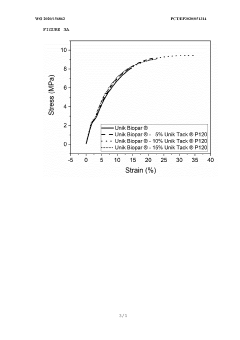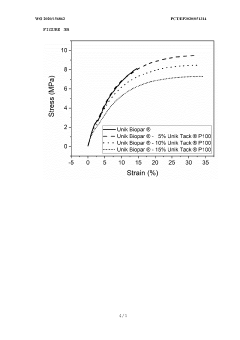Starch-Based Biodegradable Plastics Innovations
The Evolution of Starch Plastics
The evolution of starch-based biodegradable plastics represents a significant milestone in the pursuit of sustainable materials. This journey began in the late 1980s when researchers first explored the potential of starch as a biodegradable alternative to conventional plastics. Initially, starch was used as a filler in petroleum-based plastics to enhance biodegradability, but these early attempts faced challenges in terms of mechanical properties and moisture sensitivity.
The 1990s saw a shift towards developing fully starch-based plastics. Scientists focused on improving the thermoplastic properties of starch through various modification techniques, such as plasticization and blending with other biodegradable polymers. This period marked the emergence of thermoplastic starch (TPS), a material that could be processed using conventional plastic manufacturing methods.
By the early 2000s, researchers had made significant progress in enhancing the performance of starch-based plastics. The introduction of nanocomposites and the development of more sophisticated blending techniques led to improved mechanical strength, water resistance, and processability. This era also saw the first commercial applications of starch-based plastics in packaging and disposable items.
The late 2000s and early 2010s witnessed a surge in research focused on expanding the application range of starch-based plastics. Scientists explored new sources of starch, including non-food crops and agricultural waste, to address concerns about competition with food resources. Additionally, efforts were made to develop starch-based plastics with advanced functionalities, such as antimicrobial properties and controlled release capabilities for agricultural applications.
Recent years have seen a growing emphasis on circular economy principles in starch plastics development. Researchers are now focusing on designing starch-based materials that not only biodegrade but also contribute to soil health and nutrient cycling. This approach aligns with the concept of "cradle-to-cradle" design, where materials are intended to have a positive impact on the environment at the end of their life cycle.
The latest innovations in starch-based plastics involve the integration of cutting-edge technologies such as nanotechnology, biotechnology, and advanced polymer science. These interdisciplinary approaches are paving the way for next-generation materials with enhanced performance, broader applicability, and improved environmental profiles. As the field continues to evolve, starch-based biodegradable plastics are poised to play an increasingly important role in addressing global plastic pollution and advancing sustainable materials science.
Market Demand Analysis of Starch-Based Biodegradable Plastics
The market demand for starch-based biodegradable plastics has been experiencing significant growth in recent years, driven by increasing environmental concerns and regulatory pressures to reduce plastic waste. This surge in demand is particularly evident in packaging, food service, and agricultural sectors, where single-use plastics are prevalent.
Consumer awareness of environmental issues has led to a shift in preferences towards more sustainable products. A growing number of consumers are willing to pay a premium for eco-friendly alternatives, creating a favorable market environment for starch-based biodegradable plastics. This trend is especially pronounced in developed economies, where environmental consciousness is generally higher.
The packaging industry represents the largest market segment for starch-based biodegradable plastics. With the rise of e-commerce and food delivery services, there is an increasing need for sustainable packaging solutions. Starch-based materials offer a viable alternative to traditional petroleum-based plastics in applications such as food containers, bags, and protective packaging.
In the agricultural sector, starch-based biodegradable plastics are gaining traction for mulch films and plant pots. These materials can degrade naturally in soil, reducing the environmental impact and labor costs associated with removing conventional plastic products after use. The adoption of these materials is expected to grow as farmers seek more sustainable farming practices.
The food service industry is another key market for starch-based biodegradable plastics. With many countries implementing bans or restrictions on single-use plastics, restaurants and catering services are increasingly turning to biodegradable alternatives for cutlery, plates, and takeaway containers. This shift is likely to accelerate as more regions enact similar legislation.
Market analysts project robust growth for the starch-based biodegradable plastics industry. The global market size is expected to expand significantly over the next decade, with Asia-Pacific emerging as a key growth region due to its large population, increasing environmental awareness, and government initiatives promoting sustainable materials.
However, challenges remain in terms of cost competitiveness and performance compared to traditional plastics. While production costs have decreased over time, starch-based biodegradable plastics are still generally more expensive than their petroleum-based counterparts. Ongoing research and development efforts are focused on improving the mechanical properties and reducing costs to enhance market competitiveness.
The COVID-19 pandemic has had a mixed impact on the market. While it initially disrupted supply chains and manufacturing, it has also heightened awareness of hygiene and sustainability issues, potentially accelerating the long-term shift towards biodegradable materials in certain applications.
Technical Challenges
The development of starch-based biodegradable plastics faces several significant technical challenges that hinder their widespread adoption and commercialization. One of the primary obstacles is the inherent hydrophilic nature of starch, which leads to poor moisture resistance and mechanical properties in the resulting plastics. This characteristic limits their application in many sectors where traditional plastics excel, such as packaging and consumer goods.
Another major challenge lies in achieving a balance between biodegradability and durability. While rapid biodegradation is desirable for environmental reasons, it often compromises the material's strength and longevity during use. Researchers are grappling with the task of developing starch-based plastics that maintain their structural integrity throughout their intended lifespan but degrade efficiently after disposal.
The processing of starch-based materials presents additional hurdles. Starch has a high melting point and tends to degrade at temperatures required for conventional plastic processing techniques. This necessitates the development of new processing methods or the modification of existing ones to accommodate the unique properties of starch-based compounds.
Compatibility issues between starch and other polymers or additives used to enhance performance also pose significant challenges. Achieving homogeneous blends and preventing phase separation during processing and use is crucial for producing high-quality biodegradable plastics with consistent properties.
The variability in starch sources and compositions further complicates the standardization of production processes and end-product qualities. Different botanical sources of starch (e.g., corn, potato, wheat) exhibit varying molecular structures and properties, making it difficult to establish universal manufacturing protocols and quality standards.
Cost-effectiveness remains a persistent challenge in the development of starch-based biodegradable plastics. Current production methods and raw material costs often result in products that are more expensive than their petroleum-based counterparts, limiting market penetration and consumer adoption.
Lastly, ensuring complete biodegradability under various environmental conditions is an ongoing technical challenge. While starch-based plastics may degrade well in controlled composting environments, their behavior in diverse natural settings, including marine environments, is still a subject of research and improvement.
Current Solutions
01 Starch-based biodegradable plastic compositions
Various compositions of starch-based biodegradable plastics are developed to enhance biodegradability. These compositions may include different types of starches, plasticizers, and additives to improve the material properties while maintaining biodegradability.- Starch-based biodegradable plastic compositions: Various compositions of starch-based biodegradable plastics are developed to enhance biodegradability. These compositions may include different types of starches, plasticizers, and additives to improve the material properties while maintaining biodegradability. The formulations aim to balance mechanical strength, flexibility, and degradation rate to suit various applications.
- Processing methods for starch-based biodegradable plastics: Different processing techniques are employed to manufacture starch-based biodegradable plastics. These methods may include extrusion, injection molding, or film blowing. The processing conditions, such as temperature, pressure, and shear rate, are optimized to achieve desired material properties and biodegradability characteristics.
- Biodegradation mechanisms and testing methods: Research focuses on understanding the biodegradation mechanisms of starch-based plastics in various environments. Standardized testing methods are developed to assess biodegradability under different conditions, such as soil burial, composting, or aquatic environments. These tests help evaluate the degradation rate and environmental impact of the materials.
- Modifications to enhance biodegradability: Various modifications are explored to enhance the biodegradability of starch-based plastics. These may include the incorporation of enzymes, microorganisms, or other biodegradable polymers. Such modifications aim to accelerate the degradation process while maintaining the desired material properties during the product's useful life.
- Applications of starch-based biodegradable plastics: Starch-based biodegradable plastics find applications in various industries, including packaging, agriculture, and consumer goods. Research focuses on developing tailored formulations and processing methods to meet specific requirements for different applications while ensuring biodegradability. The goal is to replace conventional plastics with environmentally friendly alternatives in diverse product categories.
02 Modification techniques for starch-based plastics
Different modification techniques are employed to improve the properties of starch-based biodegradable plastics. These may include chemical modifications, blending with other biodegradable polymers, or incorporating nanoparticles to enhance biodegradability and material performance.Expand Specific Solutions03 Biodegradation assessment methods
Various methods and techniques are developed to assess the biodegradability of starch-based plastics. These may include standardized testing procedures, soil burial tests, or enzymatic degradation studies to evaluate the rate and extent of biodegradation under different environmental conditions.Expand Specific Solutions04 Enhancing biodegradation rate and efficiency
Strategies are developed to enhance the biodegradation rate and efficiency of starch-based plastics. These may include the incorporation of pro-degradant additives, optimizing the molecular structure, or developing specific microbial strains that can effectively degrade the material.Expand Specific Solutions05 Applications of starch-based biodegradable plastics
Various applications of starch-based biodegradable plastics are explored, focusing on their biodegradability in different environments. These may include packaging materials, agricultural films, disposable products, or biomedical applications where controlled biodegradation is desired.Expand Specific Solutions
Key Industry Players
The research on starch-based biodegradable plastics innovations is in a growth phase, with increasing market demand driven by environmental concerns. The global biodegradable plastics market is expanding rapidly, expected to reach $7.8 billion by 2025. Technologically, the field is advancing, with companies like Novamont SpA, Plantic Technologies Ltd., and Kingfa Sci. & Tech. Co., Ltd. leading innovations. Academic institutions such as Qingdao University of Science & Technology and Industrial Technology Research Institute are contributing to R&D efforts. The involvement of major corporations like Procter & Gamble Co. and Wacker Chemie AG indicates the technology's growing commercial viability. However, challenges in cost-effectiveness and performance compared to traditional plastics remain, suggesting room for further technological maturation.
Novamont SpA
Roquette Frères SA
Core Patents Review
- Incorporating gum rosin ester derivatives with a softening point between 80-120 °C and low acid number into starch-based biodegradable compositions, which act as compatibilizers and plasticizers, enhancing the mechanical and thermal properties and processability of the polymers.
- A process for producing starch-based biodegradable composite granules using a mixture of natural and modified starch powders, combined with biodegradable polymers and additives, which are processed to achieve a degradation period of 30-45 days, even particle size, and enhanced physical properties.
Environmental Impact
The environmental impact of starch-based biodegradable plastics is a critical aspect of their development and adoption. These innovative materials offer significant potential for reducing plastic pollution and mitigating the long-term environmental consequences associated with conventional petroleum-based plastics. Starch-based biodegradable plastics are designed to decompose naturally in the environment, breaking down into harmless substances such as water, carbon dioxide, and biomass.
One of the primary environmental benefits of starch-based biodegradable plastics is their ability to reduce the accumulation of plastic waste in landfills and natural ecosystems. Unlike traditional plastics that can persist for hundreds of years, these biodegradable alternatives can decompose within months to a few years, depending on environmental conditions. This rapid decomposition helps to alleviate the burden on waste management systems and reduces the risk of plastic pollution in oceans, rivers, and terrestrial habitats.
Furthermore, the production of starch-based biodegradable plastics often has a lower carbon footprint compared to conventional plastics. The raw materials used in their manufacture, primarily starch from crops such as corn, potatoes, or cassava, are renewable resources. This renewable nature contributes to a more sustainable production cycle and reduces dependence on finite fossil fuel resources.
However, it is important to note that the environmental impact of starch-based biodegradable plastics is not entirely without challenges. The cultivation of crops for starch production can lead to land-use changes, potentially competing with food production or contributing to deforestation if not managed sustainably. Additionally, the energy and resources required for crop cultivation and processing must be considered in the overall environmental assessment.
The end-of-life management of starch-based biodegradable plastics also presents both opportunities and challenges. While these materials can biodegrade in natural environments, they often require specific conditions to decompose efficiently. Industrial composting facilities can provide the optimal conditions for rapid biodegradation, but the availability of such facilities varies widely across regions. Improper disposal or mixing with conventional plastic waste streams can diminish the environmental benefits of these materials.
Research into improving the environmental performance of starch-based biodegradable plastics is ongoing. Scientists and engineers are working to enhance the biodegradation rates, improve the material properties to match those of conventional plastics, and develop more efficient production processes. These efforts aim to maximize the positive environmental impact while addressing potential drawbacks.
In conclusion, starch-based biodegradable plastics offer promising environmental benefits, particularly in reducing plastic pollution and fossil fuel dependence. However, their overall environmental impact must be carefully evaluated across the entire lifecycle, from production to disposal, to ensure that they truly represent a more sustainable alternative to conventional plastics.
Regulatory Framework
The regulatory framework surrounding starch-based biodegradable plastics is evolving rapidly as governments and international organizations recognize the need to address plastic pollution and promote sustainable alternatives. In the European Union, the Single-Use Plastics Directive (EU) 2019/904 has been a significant driver for the adoption of biodegradable plastics, including starch-based materials. This directive aims to reduce the impact of certain plastic products on the environment and promotes the transition to a circular economy.
In the United States, the regulatory landscape is more fragmented, with individual states taking the lead in implementing biodegradable plastic regulations. California, for instance, has enacted strict labeling requirements for biodegradable and compostable plastics through its SB 567 legislation. At the federal level, the Federal Trade Commission's Green Guides provide guidelines for environmental marketing claims, including those related to biodegradability.
Internationally, the ISO 17088 standard for compostable plastics serves as a benchmark for many countries. This standard specifies requirements for plastics and products made from plastics to be designated as compostable in municipal and industrial composting facilities. Additionally, the ASTM D6400 standard is widely used to determine the compostability of plastics.
Certification systems play a crucial role in the regulatory framework. Organizations such as TÜV Austria (OK Compost) and DIN CERTCO provide certifications for biodegradable and compostable plastics, which are recognized globally. These certifications ensure that products meet specific biodegradability and compostability standards, providing assurance to consumers and regulators alike.
Emerging regulations are focusing on the end-of-life management of biodegradable plastics. For example, the EU's Packaging and Packaging Waste Directive is being revised to include more stringent requirements for biodegradable and compostable packaging. This includes clearer labeling and improved waste management infrastructure to handle these materials effectively.
As research on starch-based biodegradable plastics continues to advance, regulatory bodies are working to keep pace with innovations. There is a growing emphasis on life cycle assessments and the development of standardized testing methods to evaluate the environmental impact of these materials. This includes considerations for soil biodegradation, marine biodegradation, and the potential for microplastic formation.
The regulatory framework also extends to the agricultural sector, where biodegradable mulch films made from starch-based plastics are gaining traction. In this context, regulations focus on ensuring these materials break down completely in soil without leaving harmful residues. The EU's EN 17033 standard for biodegradable mulch films is a key reference point in this area.



